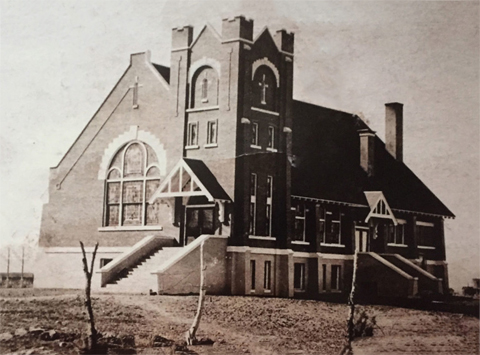By Mrs. Ada Ipsen
If you will turn to the files of the Enterprise, November, 1930, you will find the following headline: Taliesin Hughes Sr. 87, passes on following a remarkable career as pioneer of Malad Valley.
Taliesin Hughes Sr., son of James and Margaret Hughes, was born on July 13, 1843 in Myther Glammorganshire, South Wales.
When a small boy his parents heard the Mormon missionaries preach in their town and became converts to the Mormon Church and by reason of their conversion to Mormonism, they , in common with others, were imbued with a desire to gather in the headquarters of the church in America.
So Taliesin, in company with his father and mother, four brothers and sister, Maria, Gomer, Mathew, Lewis and Daniel set sail the 17th day of April, 1855, for America. The name of the ship was the Chimborazo and the captain of the ship was Peter Vesper. There were 432 Saints on board. Father was 13 years old at the time.
When they arrived in America they lived for a while in Pennsylvania where father, being an engineer by trade, secured work, as an engineer, in the coal mines. Then they moved to Kaysville, Illinois where another daughter, Sarah Ann was born.
In 1858, three years after they had reached America, before they had even reached their destination, because the family was detained while the father worked to get means to take the family to Utah, the mother died and was buried at Kaysville, Illinois overlooking the Mississippi River.
The father became disheartened and never felt a desire to continue the journey. An Uncle William Jones, who lived in Willard, Utah, went back to Illinois and brought the seven children to live in Willard. My father, now being 16 years, along with his sister Maria, 18 years, had the responsibility of taking care of the family. They lived in Willard a few years then moved to Logan where they made their home for several years. This was a great responsibility to take care of the family and father went as a young man on freighting trips to bring supplies and earn a living.
Later when father was called to go and help bring the saints to Utah, he made four trips with ox team to Florence, Nebraska. On one of these trips he tells us of a buffalo stampede in which he nearly lost his life. He married Elizabeth Roberts of Logan, Jan. 13, 1867 in the Endowment House at Salt Lake City. To this union seven children were born. The mother died May 16, 1877.
Before his wife died they moved to Samaria, Idaho where he engaged in farming and freighting.
My father then married my mother, Jane Mason, in the Endowment House in Salt Lake City, to whom 12 children were born. They resided in Samaria until 1890 when they moved to Pleasantview.
Father was one of the first pioneers who helped to settle Pleasantview, coming there when there was sage brush everywhere and the Indians had a hunting ground here. There were other families here. Among them were the families of L. W. Jones, Stephen Wight, Thomas Davis, Isaac Isaacson, Joseph Thorpe, Jerry Jones, Peter Camp, D.J. Davis Will Wight, Jonah Evans, C. B. Thomas.
Father was a very influential citizen both in religious and civil affairs. He was superintendent of the Sunday School for many years. He donated the land where the first school house was built in Pleasantview. It was also used as a church house until the present one was built.
James Evans was the contractor for this school house which still stands.
Father and Peter Fredrickson of Malad owned and operated the first thresher in the valley which he and Mr. Fredrickson operated for 17 seasons and became recognized experts with it. They threshed all over the valley. He also owned an old Osmond wire binder which he operated for many seasons.
Father was an expert swimmer, having swum Bear River many times before the bridge was built, and he said many was the time he walked to Logan, and swan the river when he came to it to get the little boat on the other side and then rowed back and got his clothes.
He helped to build the bridges, burn the sagebrush, build the fences, and produce the crops. He helped to open up the country and he laid the foundation upon which we are building today.
On January 11, 1907, father decided he would move to Logan and sell the farm he had homesteaded to the two eldest sons, Taliesin Jr. and Thomas M. and where the younger children could go to school. They lived in Loigan for 15 years but they always had a longing to come back to the farm where they had spent so many years building. So in 1922 they built a new home just north of the old home.
He was a tireless worker and was always active and was a great reader until his eyesight failed him and he was blind the last two years of his life, which was a great handicap to him. He lost his hearing early in life. He was not a man that cared to appear in public nor to give alms to be seen of men. His gifts in time and means have been generous but always on the quiet. He died Nov. 28, 1930 and was buried in the Pleasantview cemetery.
